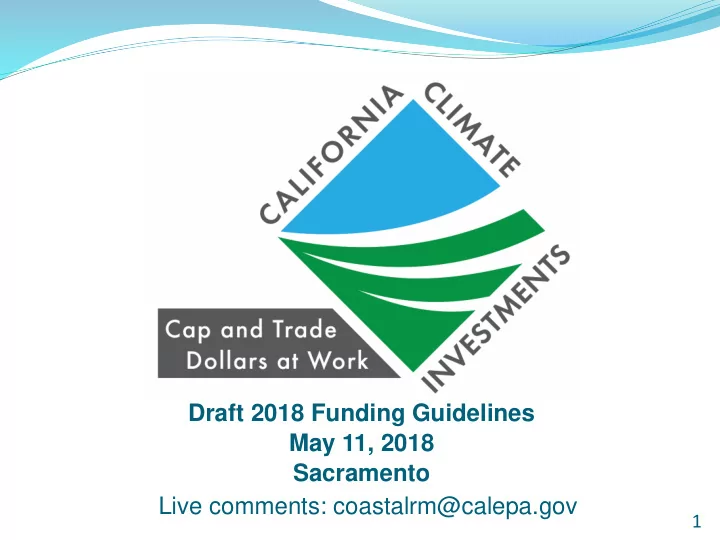

Draft 2018 Funding Guidelines May 11, 2018 Sacramento Live comments: coastalrm@calepa.gov 1
zyxwvutsrqponmlkjihgfedcbaZYXWVUTSRQPONMLKJIHGFEDCBA California Climate Investments Help to address climate change Strengthen local economies Improve public health Cap and Trade Invest around the state, Do\\ars at Work including the most vulnerable communities 2
► California Climate Investments Firm limit ao• on ¾, of em,·ss· ions 3
Funded Programs Transportation and Sustainable Communities $4,843 million Clean Energy and Energy Efficiency $402 million Natural Resources and Waste Diversion $862 million 4
Achievements $2 billion in implemented projects 51% of funding for projects benefiting disadvantaged communities 31% of funding for projects located in disadvantaged communities 23.2 million metric tons of CO 2 equivalent reduced 5
Priority Populations Assembly Bill 1550 Investment minimums – Senate Bill 535 – Assembly Bill 1550 Disadvantaged communities – Defined by CalEPA – Top 25% of CalEnviroScreen Low-income – Communities and individual households – 80% statewide median or county-specific low-income designation 6
zyxwvutsrqponmlkjihgfedcbaZYXWVUTSRQPONMLKJIHGFEDCBA ,.- - ~ Role of Funding Guidelines Assist agencies as they design programs and select projects Set guiding principles for all programs Direct agencies on how to target investments Include requirements on tracking outcomes of projects 7
zyxwvutsrqponmlkjihgfedcbaZYXWVUTSRQPONMLKJIHGFEDCBA Guidance to Agencies Describe legal requirements Tools to quantify GHG emission reductions and estimate co-benefits Strategies to target funding to priority populations Evaluation criteria to identify community needs and provide benefits to priority populations How to improve transparency and access to funds through outreach and technical assistance Methods to maximize co-benefits and foster job creation Requirements for reporting on what projects achieved 8
~ ~ "' zyxwvutsrqponmlkjihgfedcbaZYXWVUTSRQPONMLKJIHGFEDCBA Major Changes Incorporate community ~ ~ , . ' < ~ f < . o { < - feedback C , Provide guidance on co-benefits FUNDING GUIDELINES Revise demonstration of facilitation of GHG reductions C a l i f o m 1 1 Environmental Prottcbon A1111n c y Simplify administrative E 9 A i r R e s o u r c e s B o a r d Draft for Public Comment 14-k~ D.1t~= Augu,1 1 . 2 0 1 7 processes C..,mmcnh D U ( " Scp1cmbc·r IS, 2017 Cap- ;1 nd- l" radc Au, r Proceeds 1 0 n \ 1 , I l , I \ , •, I , " , l , ,1 co l 1 ] , , • , 9
zyxwvutsrqponmlkjihgfedcbaZYXWVUTSRQPONMLKJIHGFEDCBA Incorporate Community Feedback Recommendations to: – Avoid or minimize potential substantial burdens – Early and ongoing community engagement – Provide technical assistance 10
Achieve Co-benefits Economic, environmental, and public health benefits d zyxwvutsrqponmlkjihgfedcbaZYXWVUTSRQPONMLKJIHGFEDCBA . . . . . – Air quality – Cost savings – Water supply – Job creation Agencies must maximize co-benefits where feasible 11
zyxwvutsrqponmlkjihgfedcbaZYXWVUTSRQPONMLKJIHGFEDCBA Guidance on Co-benefits CARB develops methods for agencies and project applicants to estimate co-benefits Calculator tools and standalone methodologies Agencies can use methods to: – Select projects (scoring criteria) – Report project outcomes – Substantiate benefits to priority populations 12
zyxwvutsrqponmlkjihgfedcbaZYXWVUTSRQPONMLKJIHGFEDCBA GHG Emission Reductions Statute requires facilitation of GHG emission reductions Last year, programs were created including new project types (research, job training, community air monitoring) CARB revised guidance on how to meet this requirement, including the following ways: – Include all program activities – CARB quantification methods – Qualitative assessments Additional changes to procedures for public notices of how agencies will use money (Expenditure Records) 13
Community Feedback What are the most important benefits for investments (i.e., fight climate change, build resilient communities, provide health benefits, support jobs)? What are the best ways to identify community needs? What are the barriers to access funds? What do you want to know about these investments? 14
Next Steps Submit comments by May 15, 2018. – https://www.arb.ca.gov/lispub/comm2/bcsubform.php?list name=fundingguidelines-ws&comm_period=1 CARB incorporate feedback and release proposed document in July. Anticipated Board hearing July 26, 2018. 15
Thank you General program information: www.caclimateinvestments.ca.gov info@caclimateinvestments.ca.gov 1-800-757-2907 Funding Guidelines information: www.arb.ca.gov/ccifundingguidelines GGRFProgram@arb.ca.gov Submit written comments: https://www.arb.ca.gov/lispub/comm2/bcsubform.php?li stname=fundingguidelines-ws&comm_period=1 Live comments: coastalrm@calepa.gov 16
zyxwvutsrqponmlkjihgfedcbaZYXWVUTSRQPONMLKJIHGFEDCBA Questions and Comments Panelists: – Funding Guidelines – Co-benefits – Annual Report to the Legislature – Outreach and community engagement – Evaluating benefits to priority populations Live comments: coastalrm@calepa.gov 17
Recommend
More recommend